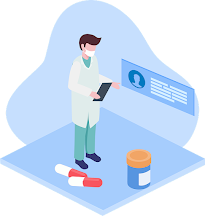Fundamentals of Medical Billing
 |
Clinical Research Courses |
Medical Billing and Coding are the backbone of the healthcare revenue cycle, ensuring payers and patients reimburse providers for services delivered. Billing and coding are separate processes, but both are crucial to receiving payment for healthcare services.
Medical billing uses those codes to create insurance claims and bills for patients. Medical billers take the codes prepared by the medical coder and submit claims to the insurance company.
They
then follow up with both the insurance company and the patients to make sure
the medical office is compensated properly, the patient is billed correctly,
and timely payments are made.
A vital process in the perpetual functioning of any hospital or medical office is medical billing. Medical billing involves preparing billing claims and submitting them to insurance providers. This ensures that the hospital or medical office is reimbursed the correct amount for the services that they provide patients. A Clinical Research Training can help you become an expert in this field.
In the following article, we shall be getting an idea of the basics and fundamentals of medical billing:
MEDICAL BILLING WORKFLOW:
Fundamentals of Medical Billing are basically how it
works out or goes about. There may be a slight difference between workflow of
different medical offices, but they still revolve around the basic fundamentals.
·
Patient Registration: Patient registration is the first step on any medical billing flow
chart. This is the collection of basic demographic information on a
patient, including name, birth date, and the reason for a visit. Insurance
information is collected, including the name of the insurance provider and the
patient's policy number, and verified by medical billers. This information is
used to set up a patient file that will be referred to during the medical
billing process.
·
Financial
Responsibility: This means looking over the patient's insurance
details to find out which procedures and services to be rendered during the
visit are covered. If there are procedures or services that will not be
covered, the patient is made aware that they will be financially responsible
for those costs.
·
Creation
of Superbill: Once the patient checks out, medical reports from the visit
are translated into diagnosis and procedure codes by a medical coder. Then, a
report called a “superbill” may be compiled from all the information gathered
thus far. It will include provider and clinician information, the patient's
demographic information and medical history, information on the procedures and
services performed, and the applicable diagnosis and procedure codes.
·
Claims
Generation: The medical biller will then use the superbill to prepare a
medical claim to be submitted to the patient's insurance company. Once the
claim is created, the biller must go over it carefully to confirm that it meets
payer and HIPPA compliance standards, including standards for medical coding
and format.
·
Monitor
Claim Adjudication: Adjudication is the process by which payers evaluate
medical claims and determine whether they are valid and compliant, and if so,
the amount of reimbursement the provider will receive. During this process, the
claim may be accepted, rejected or denied.
·
Patient
Statement Preparation: Once the claim has been processed, the patient is
billed for any outstanding charges. The statement generally includes a detailed
list of the procedures and services provided their costs, the amount paid by
insurance and the amount due from the patient.
·
Statement
Follow-Up: The last step in the medical billing process is to make
sure bills are paid. Medical billers must follow up with patients whose bills
are delinquent, and, when necessary, send accounts to collection.
Medical
billing and coding professionals can work
basically anywhere they want because of the strong call for employees
within the healthcare field!
Comments
Post a Comment